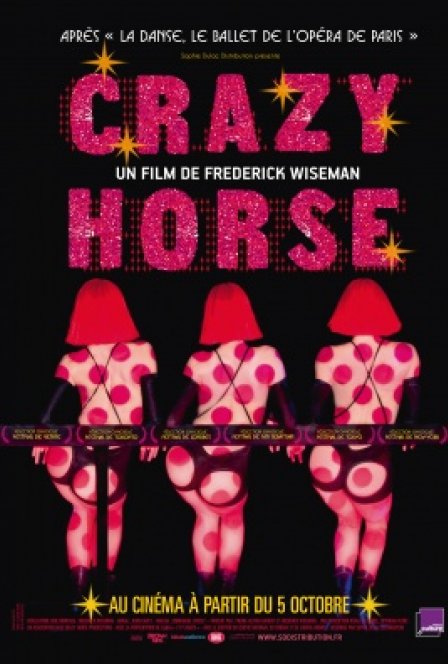It had better be an interesting and relevant question, whether naked ladies performing choreographed dances can be considered art, because otherwise there’s not much to note about Frederick Wiseman’s new documentary, Crazy Horse.
Wiseman, along with the small group of Frenchmen who run the Crazy Horse club in Paris, where 10 naked ladies who are moderately good dancers perform well-rehearsed routines while wearing costumes, certainly believes that the spectacle embodies art. There’s no doubt that dance itself is an art form, and the same goes for theater — at least in the sense of people in costumes performing on a lit stage for an audience. And a decent argument, I bet, could be made for Wiseman’s new film being a work of art, in that it aestheticizes nude dancing by putting it on film in pretty colors and editing the dancing alongside scenes of backstage life. Still, the whole thing is tenuous, if not downright unconvincing. Not a great state for a film that claims to be looking at art.
The ladies are gorgeous, and so is Wiseman’s photography, but there really is no insight into the Crazy Horse club. The most factual information we get comes in the background of a shot of audience members filing into the club’s lobby: behind them, on the wall, we read “Entering The World-Famous Crazy Horse Founded 1951.” As far as history goes, that covers it. For most of the movie, we’re asked to be content with long shots lingering on dance numbers — and unless anyone finds the dances titillating, which is hard to imagine, the point must be beauty. Wiseman is clearly entranced by the ladies, and because conveying how he feels about things is the rule in his films, he assumes we are too.
Occasionally, Wiseman moves his camera from the position of an audience member to that of a backstage guest, catching the girls lounging nude in their dressing rooms — fiddling with wigs, eating, and, in the one scene of the film that comes across ironically, laughing at a tape reel of famous ballet dancers’ onstage mistakes. The ladies are much more interesting when not performing: because their job is to appear nude before paying customers, they seem so at home being filmed nude that they pay almost no attention to Wiseman’s camera. This would seem like an excellent chance for the legendary documentarian to find out what the lives of these ladies are like, how they feel about what they do, maybe whether they consider themselves artists. But Wiseman is too set in his directorial ways for that. Real documentary filmmaking, he seems to be saying, consists in putting the camera on your subjects and letting whatever happens stand for your film. In this case, what he happens to have captured resonates very little.
The ladies don’t become whole for us. There is no probing, only vague observation. Wiseman indulges in a bit more depth with the two men who are in creative control of the ladies. The first, Philippe Decouflé, the Crazy Horse’s chief choreographer, is mostly shown butting heads with the club’s management over the short amount of time he’s been given to create new dance numbers. He doesn’t talk much about art and seems more concerned with simply pulling off the show. The second, photographer/fashion designer Ali Mahdavi — an Iranian artist world-famous for his designs and for his photographs of his designs — has nothing but confidence in the artistic merit of what he does. Wiseman includes as much footage of Mahdavi talking as he does of Decouflé choreographing, though the role that the former plays at the Crazy Horse is never specified. Whatever Mahdavi actually does, he and Decouflé are the largest onscreen presences in the movie and make up the closest thing to a statement that Crazy Horse could be said to make. They are something like the yin and yang of whatever stands for the philosophy of the Crazy Horse. Whether I believe either of them is a different story, one that Wiseman unfortunately cares nothing about.
Wiseman is a legend in documentary filmmaking, and anyone who’s seen his past work will realize that he is only doing with the Crazy Horse what he’s done with all of his subjects. In that sense, I can see that I’m missing the point, at least the point that Wiseman would like to have us understand: we’re supposed to be getting his personal feelings about the Crazy Horse, rather than a portrait of the tradition or meaning of French nude dancing. He’s really asking his audience to see what he sees and draw their own conclusions. Which is fine, but my conclusion is boredom. And I don’t think that makes me an opponent of the art of nude dancing, if such a thing exists. If Wiseman wants us to see the world as he was feeling it as he filmed, I can only conclude that he must have been bored, too.

